PONTIAC GRAND AM 2005 Workshop Manual
Manufacturer: PONTIAC, Model Year: 2005, Model line: GRAND AM, Model: PONTIAC GRAND AM 2005Pages: 334, PDF Size: 2.27 MB
Page 51 of 334
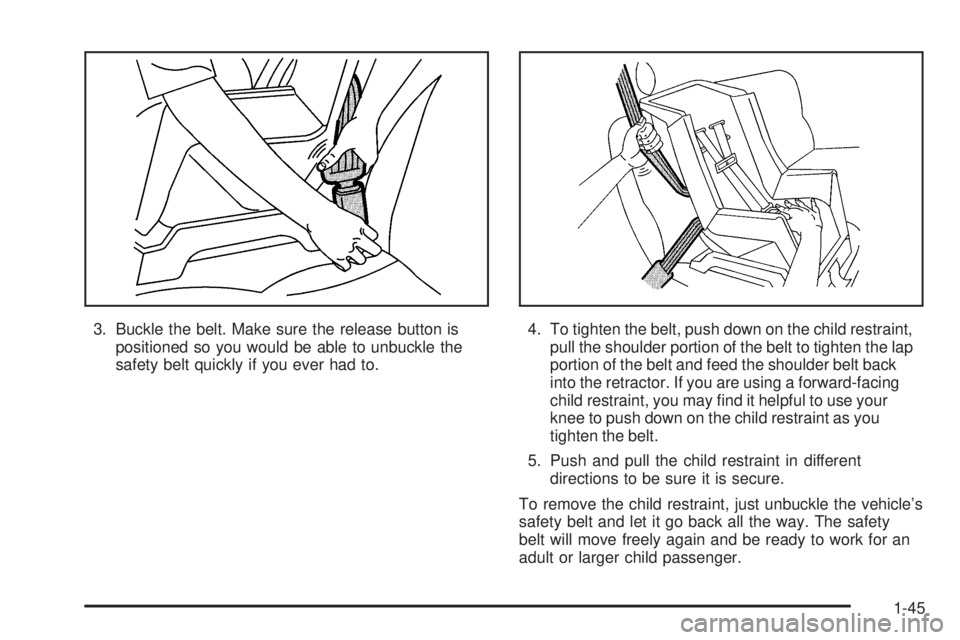
3. Buckle the belt. Make sure the release button is
positioned so you would be able to unbuckle the
safety belt quickly if you ever had to.4. To tighten the belt, push down on the child restraint,
pull the shoulder portion of the belt to tighten the lap
portion of the belt and feed the shoulder belt back
into the retractor. If you are using a forward-facing
child restraint, you may find it helpful to use your
knee to push down on the child restraint as you
tighten the belt.
5. Push and pull the child restraint in different
directions to be sure it is secure.
To remove the child restraint, just unbuckle the vehicle’s
safety belt and let it go back all the way. The safety
belt will move freely again and be ready to work for an
adult or larger child passenger.
1-45
Page 52 of 334

Securing a Child Restraint in a
Center Rear Seat Position
If your child restraint is equipped with the LATCH
system, seeLower Anchorages and Top Tethers for
Children (LATCH System) on page 1-41. SeeTop Strap
on page 1-39if the child restraint has one.
If your child restraint does not have the LATCH system,
you will be using the lap belt to secure the child
restraint in this position. Be sure to follow the
instructions that came with the child restraint. Secure
the child in the child restraint when and as the
instructions say.
1. Make the belt as long as possible by tilting the latch
plate and pulling it along the belt.
2. Put the child restraint on the seat.
3. Run the vehicle’s safety belt through or around the
restraint. The child restraint instructions will show
you how.
1-46
Page 53 of 334

4. Buckle the belt. Make sure the release button is
positioned so you would be able to unbuckle the
safety belt quickly if you ever had to.
5. To tighten the belt, pull its free end while you push
down on the child restraint. If you are using a
forward-facing child restraint, you may find it helpful
to use your knee to push down on the child
restraint as you tighten the belt.
6. Push and pull the child restraint in different
directions to be sure it is secure.
To remove the child restraint, just unbuckle the vehicle’s
safety belt. It will be ready to work for an adult or
larger child passenger.
1-47
Page 54 of 334
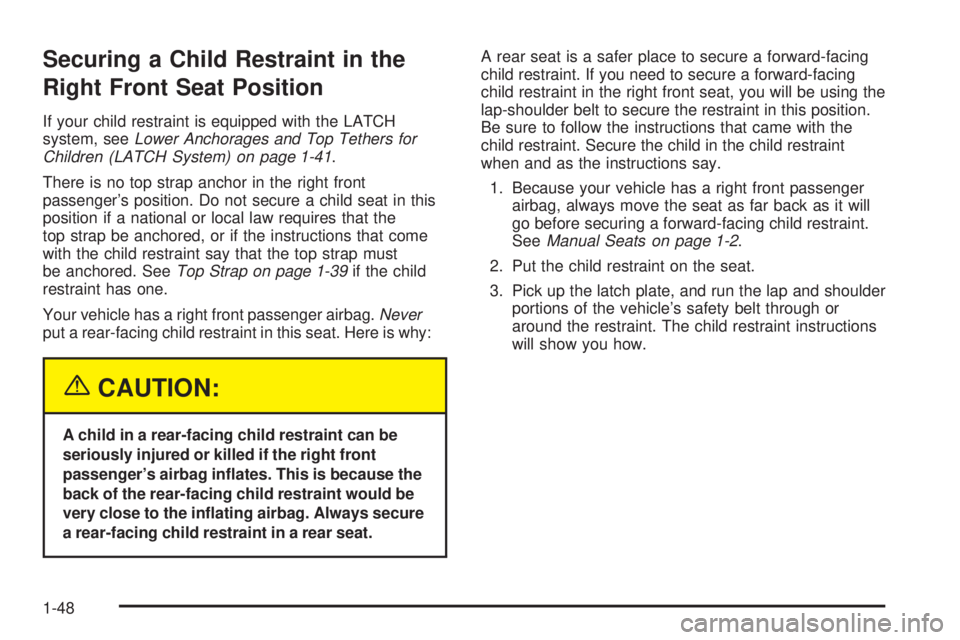
Securing a Child Restraint in the
Right Front Seat Position
If your child restraint is equipped with the LATCH
system, seeLower Anchorages and Top Tethers for
Children (LATCH System) on page 1-41.
There is no top strap anchor in the right front
passenger’s position. Do not secure a child seat in this
position if a national or local law requires that the
top strap be anchored, or if the instructions that come
with the child restraint say that the top strap must
be anchored. SeeTop Strap on page 1-39if the child
restraint has one.
Your vehicle has a right front passenger airbag.Never
put a rear-facing child restraint in this seat. Here is why:
{CAUTION:
A child in a rear-facing child restraint can be
seriously injured or killed if the right front
passenger’s airbag in�ates. This is because the
back of the rear-facing child restraint would be
very close to the in�ating airbag. Always secure
a rear-facing child restraint in a rear seat.A rear seat is a safer place to secure a forward-facing
child restraint. If you need to secure a forward-facing
child restraint in the right front seat, you will be using the
lap-shoulder belt to secure the restraint in this position.
Be sure to follow the instructions that came with the
child restraint. Secure the child in the child restraint
when and as the instructions say.
1. Because your vehicle has a right front passenger
airbag, always move the seat as far back as it will
go before securing a forward-facing child restraint.
SeeManual Seats on page 1-2.
2. Put the child restraint on the seat.
3. Pick up the latch plate, and run the lap and shoulder
portions of the vehicle’s safety belt through or
around the restraint. The child restraint instructions
will show you how.
1-48
Page 55 of 334

4. Buckle the belt. Make sure the release button is
positioned so you would be able to unbuckle the
safety belt quickly if you ever had to.5. Pull the rest of the shoulder belt all the way out of
the retractor to set the lock.
1-49
Page 56 of 334
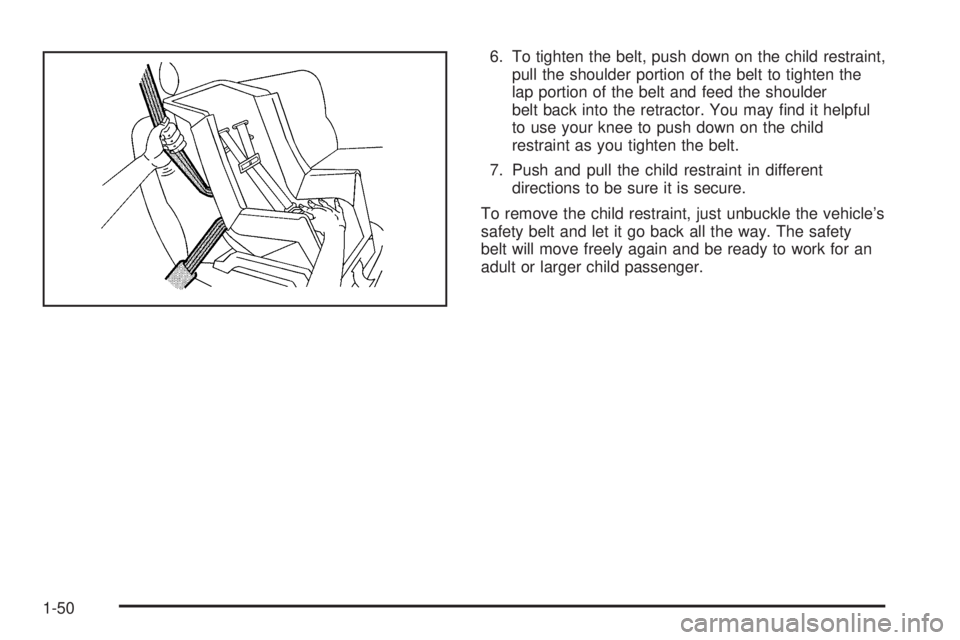
6. To tighten the belt, push down on the child restraint,
pull the shoulder portion of the belt to tighten the
lap portion of the belt and feed the shoulder
belt back into the retractor. You may find it helpful
to use your knee to push down on the child
restraint as you tighten the belt.
7. Push and pull the child restraint in different
directions to be sure it is secure.
To remove the child restraint, just unbuckle the vehicle’s
safety belt and let it go back all the way. The safety
belt will move freely again and be ready to work for an
adult or larger child passenger.
1-50
Page 57 of 334

Airbag System
Your vehicle has airbags — one airbag for the driver
and another airbag for the right front passenger.
Frontal airbags are designed to help reduce the risk of
injury from the force of an inflating airbag. But these
airbags must inflate very quickly to do their job
and comply with federal regulations.
Here are the most important things to know about the
airbag system:
{CAUTION:
You can be severely injured or killed in a crash
if you are not wearing your safety belt — even
if you have airbags. Wearing your safety belt
during a crash helps reduce your chance of
hitting things inside the vehicle or being
ejected from it. Airbags are designed to work
with safety belts, but do not replace them.
Airbags are designed to deploy only in
moderate to severe frontal and near frontal
crashes. They are not designed to in�ate in
CAUTION: (Continued)
CAUTION: (Continued)
rollover, rear or low-speed frontal crashes, or
in many side crashes. And, for some
unrestrained occupants, airbags may provide
less protection in frontal crashes than more
forceful airbags have provided in the past.
Everyone in your vehicle should wear a safety
belt properly — whether or not there is an
airbag for that person.
{CAUTION:
Airbags in�ate with great force, faster than the
blink of an eye. If you are too close to an
in�ating airbag, as you would be if you were
leaning forward, it could seriously injure you.
Safety belts help keep you in position before
and during a crash. Always wear your safety
belt, even with airbags. The driver should sit
as far back as possible while still maintaining
control of the vehicle.
1-51
Page 58 of 334
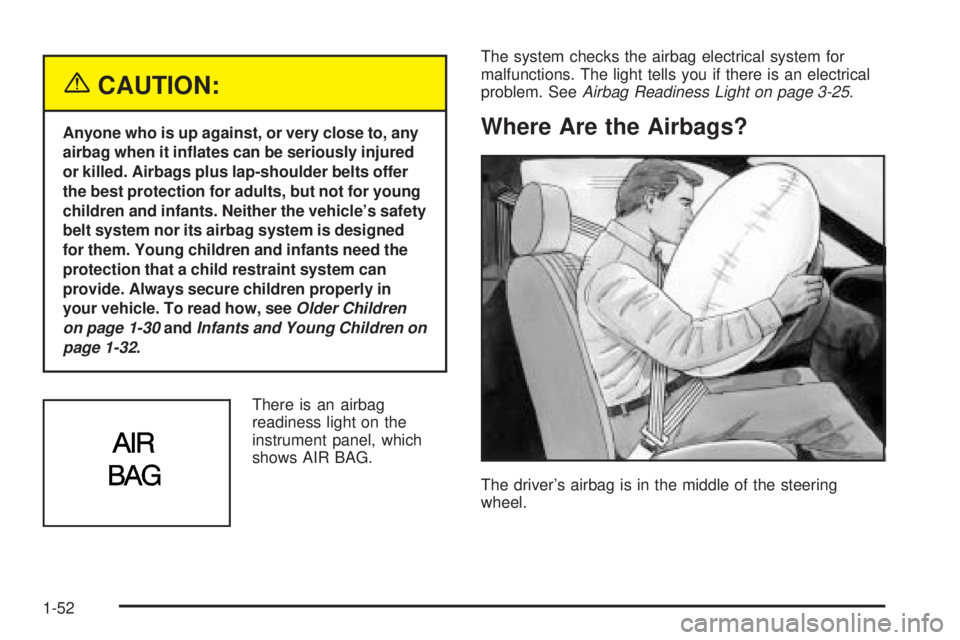
{CAUTION:
Anyone who is up against, or very close to, any
airbag when it in�ates can be seriously injured
or killed. Airbags plus lap-shoulder belts offer
the best protection for adults, but not for young
children and infants. Neither the vehicle’s safety
belt system nor its airbag system is designed
for them. Young children and infants need the
protection that a child restraint system can
provide. Always secure children properly in
your vehicle. To read how, seeOlder Children
on page 1-30andInfants and Young Children on
page 1-32.
There is an airbag
readiness light on the
instrument panel, which
shows AIR BAG.The system checks the airbag electrical system for
malfunctions. The light tells you if there is an electrical
problem. SeeAirbag Readiness Light on page 3-25.Where Are the Airbags?
The driver’s airbag is in the middle of the steering
wheel.
1-52
Page 59 of 334
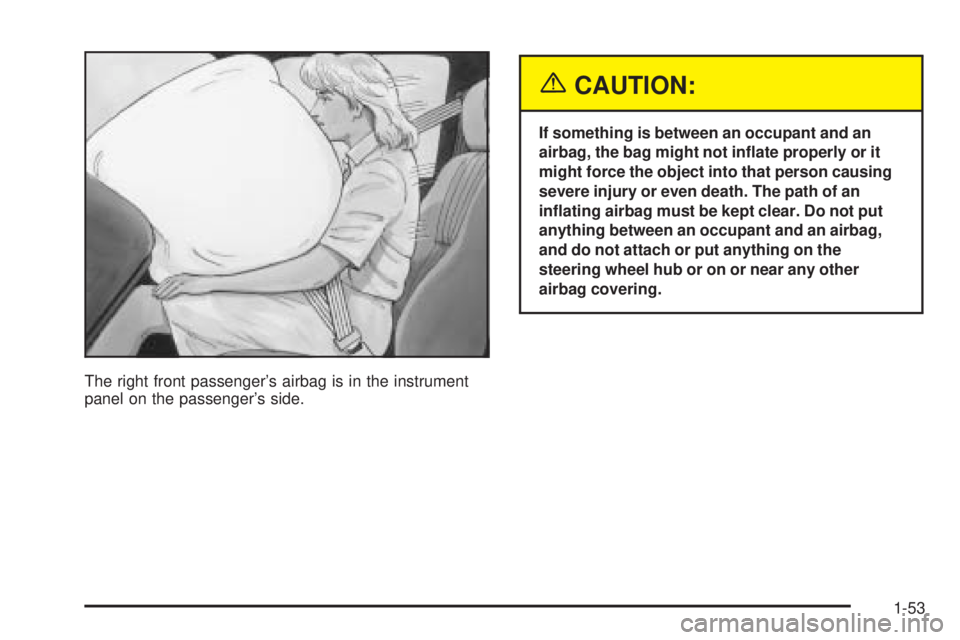
The right front passenger’s airbag is in the instrument
panel on the passenger’s side.
{CAUTION:
If something is between an occupant and an
airbag, the bag might not in�ate properly or it
might force the object into that person causing
severe injury or even death. The path of an
in�ating airbag must be kept clear. Do not put
anything between an occupant and an airbag,
and do not attach or put anything on the
steering wheel hub or on or near any other
airbag covering.
1-53
Page 60 of 334
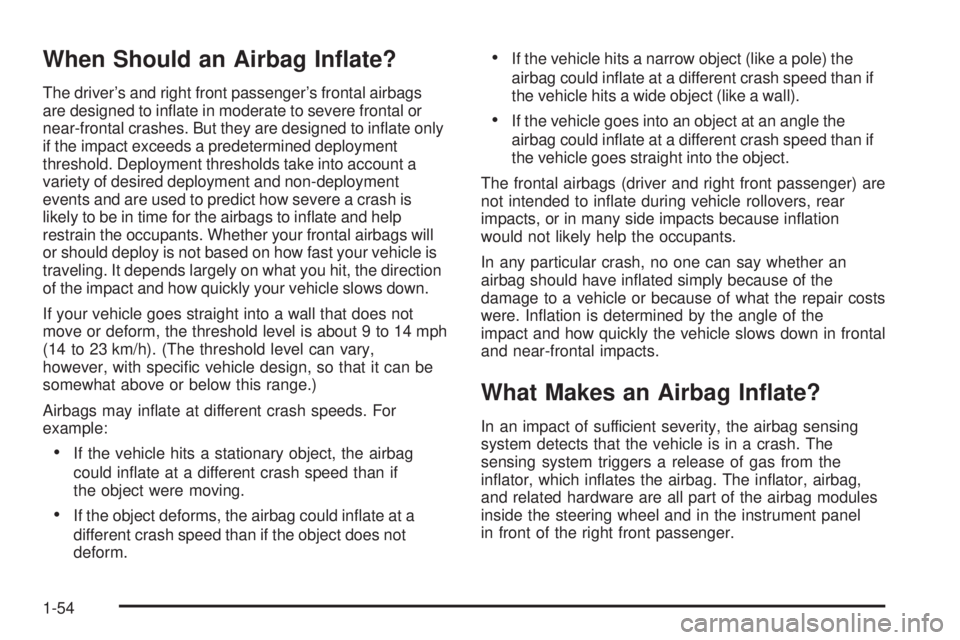
When Should an Airbag In�ate?
The driver’s and right front passenger’s frontal airbags
are designed to inflate in moderate to severe frontal or
near-frontal crashes. But they are designed to inflate only
if the impact exceeds a predetermined deployment
threshold. Deployment thresholds take into account a
variety of desired deployment and non-deployment
events and are used to predict how severe a crash is
likely to be in time for the airbags to inflate and help
restrain the occupants. Whether your frontal airbags will
or should deploy is not based on how fast your vehicle is
traveling. It depends largely on what you hit, the direction
of the impact and how quickly your vehicle slows down.
If your vehicle goes straight into a wall that does not
move or deform, the threshold level is about 9 to 14 mph
(14 to 23 km/h). (The threshold level can vary,
however, with specific vehicle design, so that it can be
somewhat above or below this range.)
Airbags may inflate at different crash speeds. For
example:
•If the vehicle hits a stationary object, the airbag
could inflate at a different crash speed than if
the object were moving.
•If the object deforms, the airbag could inflate at a
different crash speed than if the object does not
deform.
•If the vehicle hits a narrow object (like a pole) the
airbag could inflate at a different crash speed than if
the vehicle hits a wide object (like a wall).
•If the vehicle goes into an object at an angle the
airbag could inflate at a different crash speed than if
the vehicle goes straight into the object.
The frontal airbags (driver and right front passenger) are
not intended to inflate during vehicle rollovers, rear
impacts, or in many side impacts because inflation
would not likely help the occupants.
In any particular crash, no one can say whether an
airbag should have inflated simply because of the
damage to a vehicle or because of what the repair costs
were. Inflation is determined by the angle of the
impact and how quickly the vehicle slows down in frontal
and near-frontal impacts.
What Makes an Airbag In�ate?
In an impact of sufficient severity, the airbag sensing
system detects that the vehicle is in a crash. The
sensing system triggers a release of gas from the
inflator, which inflates the airbag. The inflator, airbag,
and related hardware are all part of the airbag modules
inside the steering wheel and in the instrument panel
in front of the right front passenger.
1-54